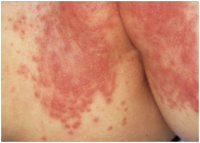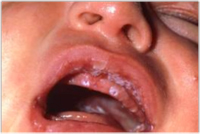What is Candidiasis or thrush?
Candidiasis (sometimes called moniliasis or a yeast infection) is an infection caused by yeast on the skin and mucous membranes. When the infection occurs in the mouth, it is called thrush. If an infant has thrush, there is a chance that the infant also has a yeast infection in the diaper area.
What causes thrush?
Thrush is caused by a fungus called Candida albicans. It occurs mostly in the neonate and infant. The following are some of the factors that may increase the chance of the infant developing thrush:
- Antibiotics – Antibiotics can cause yeast to grow, because the normal bacteria in tissues are killed off, letting the yeast grow unhampered. And there is therefore more yeast in the GI tract (gastrointestinal tract)
- Steroids – Steroids may decrease the child’s immune system and decrease the ability to fight normal infections.
- Poor immune system – If the infant has a poor immune system and an inability to fight infection from another chronic disease, he/she is at an increased risk for developing thrush.
- Less than ideal hand washing after diaper change
 What are the symptoms of Candidiasis?
What are the symptoms of Candidiasis?
The following are the most common symptoms of Candidiasis. However, each child may experience symptoms differently. Symptoms may include:
In the mouth (thrush):
- White patches on the cheeks or throat (these white lesions do not scrape off easily).
- Apparent pain when sucking bottle
In the diaper area:
- Very red lesions with well-defined edges (lesions may be raised).
Yeast infections in the diaper area usually have satellite lesions away from the diaper area (i.e., on the stomach or thighs). A boy’s scrotum may also be affected. The symptoms of Candidiasis may resemble other dermatologic conditions or medical problems. Consult your child’s physician for diagnosis.
Treatment may include:
In the mouth (thrush):
- Anti-fungal medication that is applied on the lesions in the mouth
- Gentian violet is purple dye. When it enters the yeast cells it causes them to burst open and die. It is very effective, but very messy. It is an “old- fashioned” treatment. It can be used in conjunction with nystatin.
A mother who is breastfeeding may also need to be treated if she has a yeast infection on her breasts. This will help decrease the chance of re-infecting the infant.
In the diaper area:
- Anti-fungal diaper cream containing Nystatin
- OTC creams including Dr. Smiths, Lotrimin, and Triple paste.
Keep your child’s diaper area clean and dry. Let your child’s bottom be exposed to air for approximately 15 minutes, several times throughout the day.
Vaginitis due to monilla/ other causes
- Prescription cream with nystatin
- Soak in bath with baking soda
- STOP: Bubble baths, perfumed toilet paper or soaps, anything “clingy” like bathing suits, nylon underwear.

